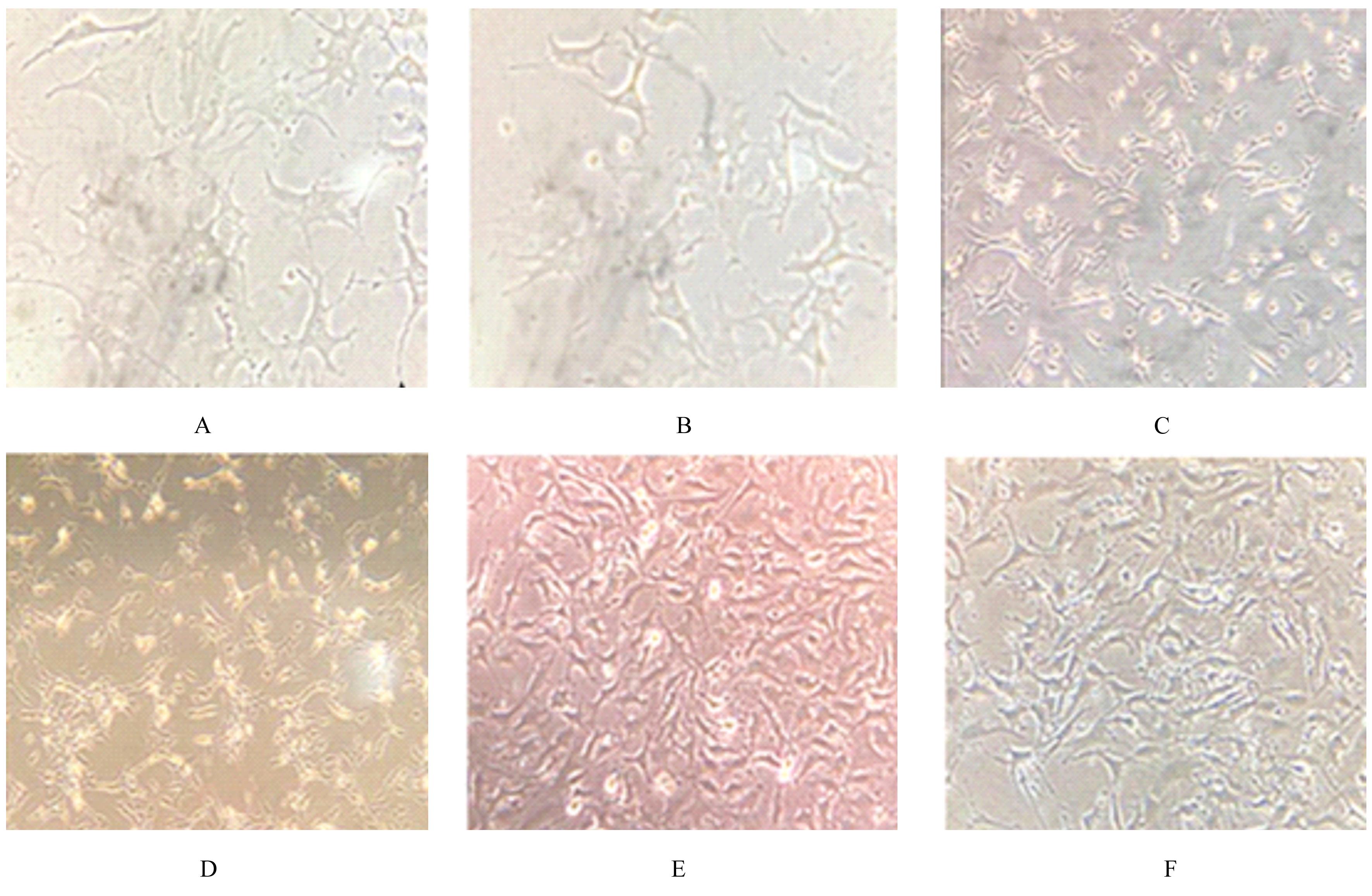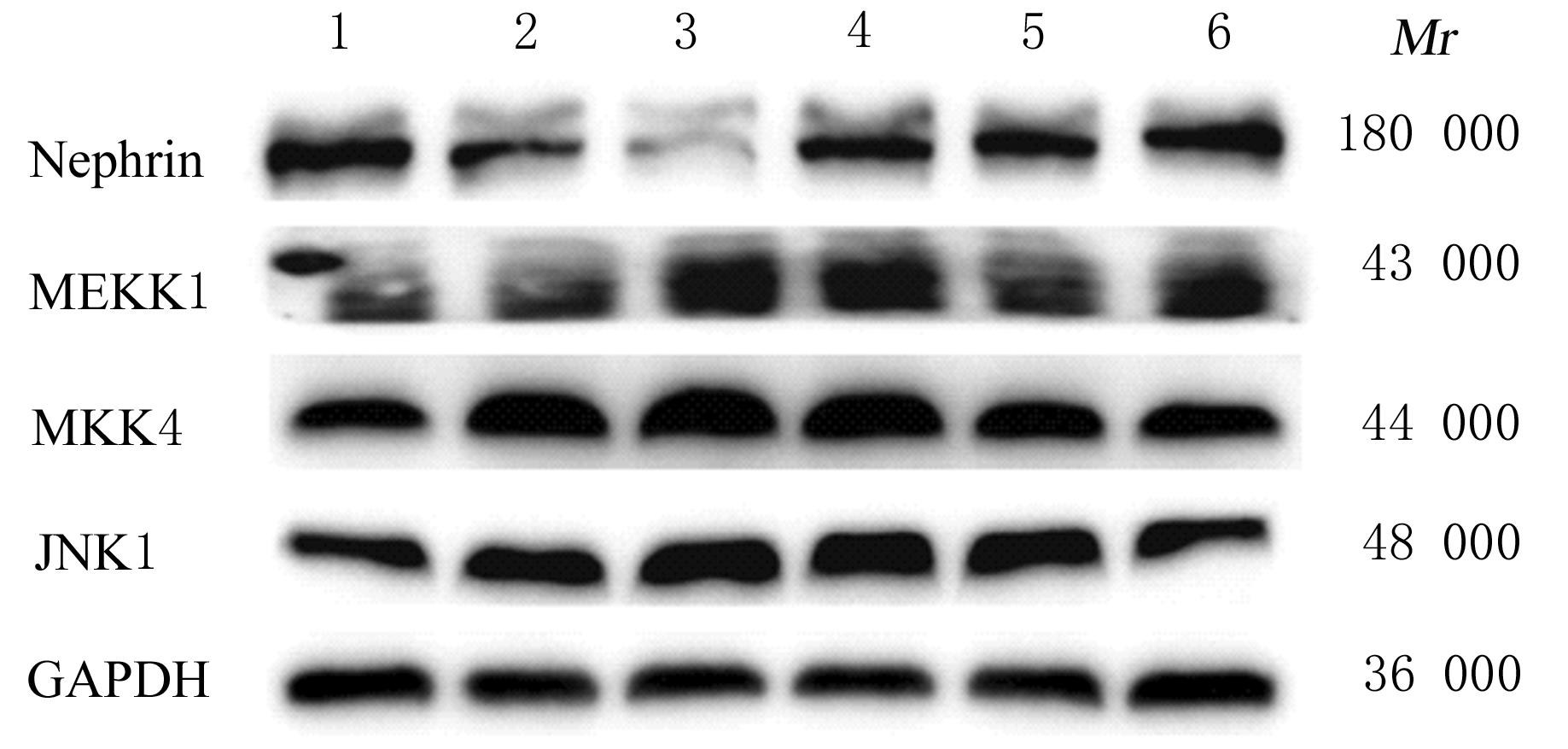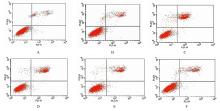吉林大学学报(医学版) ›› 2022, Vol. 48 ›› Issue (6): 1403-1410.doi: 10.13481/j.1671-587X.20220605
丝胶对高糖所致足细胞损伤和JNK信号通路的影响
- 承德医学院人体解剖学教研室,河北 承德 067000
Effects of sericin on injury of podocytes induced by high glucose and JNK signaling pathway
Donghui LIU,Mingxi ZHANG,Wenliang FU,Xiumei FU,Chengjun SONG( ),Zhihong CHEN(
),Zhihong CHEN( )
)
- Department of Human Anatomy,Chengde Medical College,Chengde 067000,China
摘要:
目的 探讨丝胶对高糖所致足细胞损伤时c-Jun氨基末端激酶(JNK)信号通路相关蛋白的表达及足细胞凋亡的影响,阐明丝胶的保护作用及其可能机制。 方法 分化成熟的条件永生化小鼠足细胞随机分为正常对照组(含5.5 mmol·L-1葡萄糖的培养基)、高渗对照组(含5.5 mmol·L-1葡萄糖+24.5 mmol·L-1甘露醇的培养基)、高糖组(含30.0 mmol·L-1葡萄糖的培养基)、低浓度丝胶组(含30.0 mmol·L-1葡萄糖+150.0 mg·L-1丝胶的培养基)、中浓度丝胶组(含30.0 mmol·L-1葡萄糖+300.0 mg·L-1丝胶的培养基)和高浓度丝胶组(含30.0 mmol·L-1葡萄糖+600.0 mg·L-1丝胶的培养基)。采用光学倒置显微镜观察各组足细胞形态表现,实时荧光定量PCR(RT-qPCR)法检测各组足细胞中裂孔膜蛋白(Nephrin)、丝裂原活化蛋白激酶激酶1(MEKK1)、丝裂原活化蛋白激酶激酶4(MKK4)、c-Jun氨基末端激酶1(JNK1)和c-Jun mRNA表达水平,Western blotting法检测各组足细胞中Nephrin、MEKK1、MKK4、JNK1和c-Jun蛋白表达水平,AnnexinⅤ/PI双染法检测各组足细胞凋亡率。 结果 正常对照组足细胞胞体较大,并延伸生出树枝状突起;与正常对照组比较,高糖组足细胞胞体回缩变小,细胞间隔增大,脱落和悬浮的足细胞数目增多;与高糖组比较,不同浓度丝胶组足细胞形态逐渐趋于正常。高糖组足细胞中Nephrin mRNA和蛋白表达水平较正常对照组均明显降低(P<0.05),表明高糖致足细胞损伤模型建立成功。高糖组足细胞中MEKK1、MKK4、JNK1、c-Jun mRNA和蛋白表达水平较正常对照组明显升高(P<0.05);不同浓度丝胶组足细胞中MEKK1、MKK4、JNK1和c-Jun mRNA及蛋白表达水平较高糖组明显降低(P<0.05),且高浓度丝胶组足细胞中MEKK1、MKK4、JNK1和c-Jun mRNA及蛋白表达水平较中浓度丝胶组明显降低(P<0.05),中浓度丝胶组足细胞中MEKK1、MKK4、JNK1和c-Jun mRNA及蛋白表达水平较低浓度丝胶组明显降低(P<0.05)。高糖组和高渗对照组足细胞凋亡率较正常对照组明显升高(P<0.05);不同浓度丝胶组足细胞凋亡率较高糖组明显降低(P<0.05),且高浓度丝胶组足细胞凋亡率较中浓度丝胶组明显降低(P<0.05),中浓度丝胶组足细胞凋亡率较低浓度丝胶组明显降低(P<0.05)。 结论 丝胶对高糖所致足细胞损伤发挥保护作用,其机制可能与抑制JNK信号通路中MEKK1、MKK4、JNK1和c-Jun的表达及抑制足细胞凋亡有关联。
中图分类号:
- R587.1








